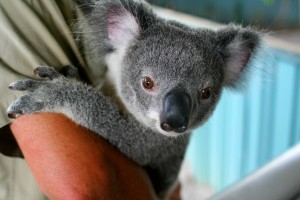Saving Australia’s Koalas

 In an emergency room at Beerwah, Queensland, the phone rings almost 100 times a day.
In an emergency room at Beerwah, Queensland, the phone rings almost 100 times a day.
The emergency room is one at the Australian Wildlife Hospital, providing veterinary care for sick and injured wildlife — admitting anywhere in the region of 30 different species on a daily basis — with injuries resulting from accidents, acts of deliberate cruelty, or conflict.
Arethusa came into the emergency room suffering from fractured ribs and internal abdominal bleeding. Frodo came in with a gunshot wound, sustaining a fractured skull and significant damage to the stomach and intestines. Travis and his mother were run over by a hit and run vehicle.
These four were koalas, but the hospital deals in animals common to the Australian landscape — from Brushtail Possums to Bearded Dragons.
The koalas themselves, cute cuddly creatures, with a sleepy demeanour, renowned as a representation of Australia have recently been in the news for being endangered and for a curious case of koala chlamydia. Koalas are in serious decline, suffering from many of the effects the veterinarians at the Australian Wildlife Hospital see on a daily basis — as well as habitat destruction, domestic dog attacks, bushfires and disease. The Australian Koala Foundation estimates that there are less than 80,000 koalas left in the wild, possibly as few as 43,000.
Over the past few years researchers have been distilling and putting together a case to add another reason for koala decline to the list. Roughly 600 koalas per year are seen to at the hospital, and most present with other primary conditions. A number of koalas, however, have presented at the hospital with serious illness associated with regenerative anaemia and now trypanosome infections.
The trypanosome is a parasite we commonly associate with African Trypanosomiasis (as well Chagas disease). In reality, the trypanosome also infects rats, cattle, and even kangaroos.
To say little is known about systemic and blood parasites of native wildlife in Australia would be an understatement. Researchers are only just beginning to understand the diversity of trypanosomes in Australian marsupials. Much is still to be learnt. Their evolutionary biology, transmission, and resulting potential impact on the wildlife. The possibility that indigenous wildlife trypanosomes can act as a reservoir for human pathogenic infections is all to be seen.
What we do know is that, in Australia, the introduction of trypanosomes are as a direct result of human activities. Being almost certainly responsible for introducing trypanosomes from one wildlife population to another. The vector — what transmits the parasite from animal to animal — of Australian trypanosomes is not known. Although, researchers have the flea in mind as the usual suspect.
To date around 10 trypanosome species and genotypes have been identified in marsupials; from the northern brown bandicoot, the platypus, the woylie, the chuditch, the eastern grey kangaroo, the common wombat, and the swamp wallaby.
The koalas that came into that emergency room over a two year period were systematically studied; collecting blood samples during routine veterinary examinations, detailing geographical origin, as well as sex, age and reason for admission. The standard patient history.
One such patient led to the description (morphologically, pathologically, and genetically) of a trypanosome in the blood. A new species, named Trypanosoma irwini… named in honour of the late great Australian Steve Irwin. A fitting tribute to an original patron of the Australian Wildlife Hospital.
Image — source.
 Follow
Follow
1 thought on “Saving Australia’s Koalas”
Comments are closed.